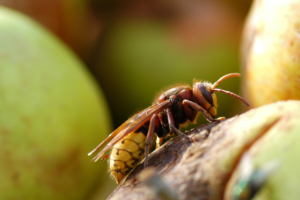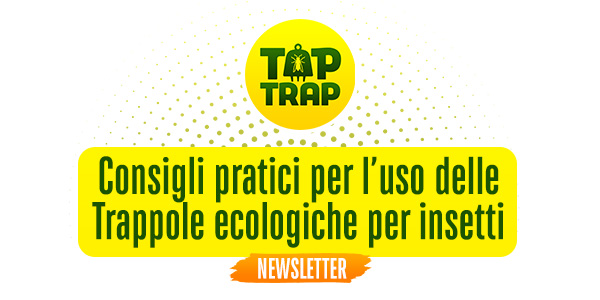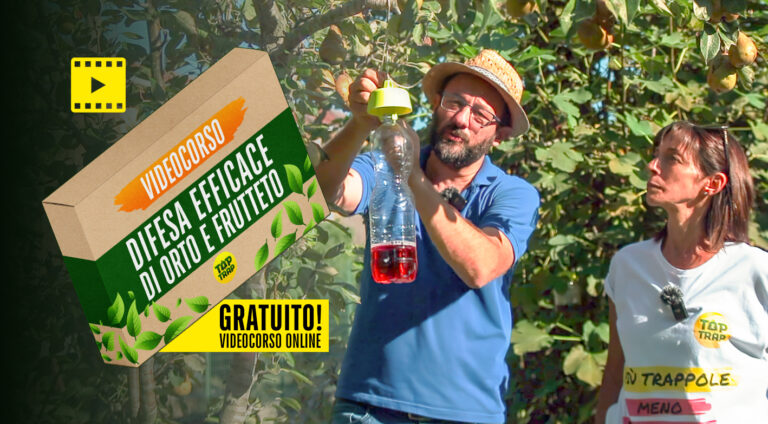
(click on the trap to learn how to use it or read the advices for a home defence or for the apiary defence)
How to get rid of hornets and wasps and stop suffering the nuisance of having them around in the garden, in the orchard or under the porch at home? They make nests everywhere, in attics rather than in trees, or in hidden cavities, usually in quiet places where they can grow their colony undisturbed. Spring trapping of founding queens is essential to slow down the proliferation of the vespid population. The most effective procedure is achieved by placing traps on the plants surrounding the hives, using simple beer bait, which in our experiments proved to be the most attractive substance at this time of year.
The wasp traps that work in the most effective way without the use of insecticides are those with colour attraction using food bait. Colour attractiveness is successful with wasps even when there are not yet ripe fruits on the plants: the typical yellow of Tap Trap Caps is the colour primarily attractive to insects and is specially designed to attract them and make them mistake the trap for a fruit even in the less cold days of late winter.
When the wasp approaches the trap, it is enticed by the smell of the bait and enters the trap to feed. But the function of the bait is not only attractive: depending on how it is prepared, the bait is able to attract some types of insects and others not. This is very important because it facilitates the selection of the target insect and keeps useful insects, such as ladybirds, bees and bumblebees, which have no food interest in the attractive solutions we recommend for wasps, away from the trap. You can find the recipes for the baits in the traps tab: they have all been tried and tested for several years now, not only by us but also by those who have been using this method of defence for a long time.

![]()
Among the good practices for bee breeding, it is essential to know how to place the apiary in an appropriate place. The beehive, in fact, is a perfect machine where every bee has a very specific role: the task of the beekeeper is to monitor the health of bees and ensure a healthy environment, which favors their rhythms, their needs, even before thinking about the production of honey. Although it will always be possible to move the beehives in the future, it is recommended that a final decision be taken from the start.
The surrounding environment must also be monitored and kept as healthy as possible: pests, infectious agents, pesticides and environmental changes can weaken bees and make them more susceptible to various diseases. Furthermore, it is essential to protect them against predatory insects, which in addition to decimating families, can cause great stress to our small friends.
The most dangerous bee predators in Italy and in the Mediterranean area are the Vespa crabro (European hornet) and the Vespa velutina. These vespids attack bees in the summer, killing them to bring nourishment to the colony waiting in the nest. It also happens that they hunt them from the hive step, causing great stress to the entire family, or entering directly into the hive to pillage it.
The defence objective is not only to eliminate wasps when they occur, but to try to ensure that there are fewer of them each season. How? By abating their reproduction rate. This is why the beekeeping equipment of a good beekeeper must include wasp traps of two types:
WANT TO LEARN MORE ABOUT HARMFUL INSECTS BEHAVIOUR? READ OUR FLYING PESTS GUIDE

(Some in-depth news articles full of advices on defence timing and methodology)
Head Office:
Via Caduti per la Libertà, 39
10044 PIANEZZA (TO)
Warehouse:
Via dei Ronchi, 61
10091 Alpignano (TO)
Tel. +39 011.988.68.40![]() +39 379.2370074
+39 379.2370074
info@taptrap.com

CARELLO ROBERTO di BELLINI VANDA
Copyright © 2024 All rights reserved
VAT no. IT12508090011 – C.F. BLLVND57L43H355W –
N.REA TO1295145

Iscriviti e ricevi subito un coupon di € 5
da utilizzare nel nostro shop online

Scopri il nostro videocorso gratuito
DIFESA EFFICACE di Orto e Frutteto
Tanti consigli pratici per prevenire le infestazioni di insetti dannosi in modo ecologico – con Pietro Isolan